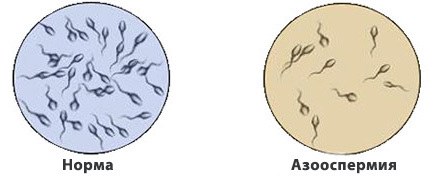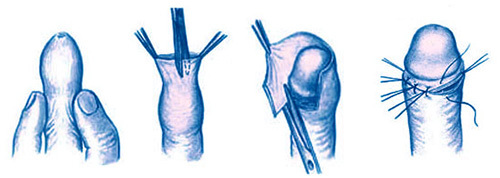The main symptoms of kidney stones in men and their therapy
Kidney stones in men are a manifestation of urolithiasis. In this case, specific formations are formed - stones( stones), which are localized mainly in the kidneys( less often in the bladder or in the ureters).The disease brings a lot of trouble and can lead to serious complications. Stones in the kidney and ureter.
Content
- 1 Causes of kidney stones
- 2 Symptoms of kidney stones
- 2.1 Signs of stones
- 2.2 stones Exit Signs
- 3 Diagnostics
- 4 Treatment
- 4.1 Drug therapy
- 4.2 Surgical removal
- 4.3 Diet
- 5 Prevention of urolithiasis
- 5.1 Primary prevention
- 5.2 Secondary prevention
Reasons for the formation of kidney stones
This pathology is also found in women, but, according to statistics, Men are more prone to the formation of kidney stones. The reason lies in the features of the genitourinary system of the male body, primarily in the presence of the prostate and the longer urethra.
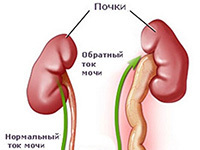
Violation of the outflow of urine provokes the deposition of salts from which stones are formed.
With inflammatory narrowing of the urethra, development of prostate adenoma and chronic prostatitis, normal urine outflow is disrupted, which leads to the development of stagnant phenomena in the kidneys and precipitation of salts. Of these, in the end, and stones are formed. At first, small, grains of sand gradually increase in size, become covered with new salt deposits and turn into formations capable, in especially severe cases, to block the ureter. This can lead to a serious complication - kidney hydronephrosis and the development of kidney failure.
In addition to these features characteristic of the male body, there are a number of other factors that contribute to the development of urolithiasis:
- Rigid drinking water. The appearance of kidney stones is very often the result of drinking low-quality drinking water. In many regions of our country the water is very hard, contains an excessive amount of calcium salts( see Selecting a water filter).
- Power. Incorrect food, when meat predominates in food, leads to the formation of urate salts. If the diet is too much cottage cheese and milk, there is a danger of developing calcium calculus.
- Insufficient drinking regimen. Stone formation can contribute to insufficient water intake. Most often this situation occurs in areas with a hot climate, when the body loses a lot of fluid with sweat( see How to maintain the water balance in the male body).
- Infections and medicines. Genito-urinary infections and a number of drugs can also be the cause of calculus formation.
There are many assumptions, but all scientists tend to believe that the disease is associated with the characteristics of the exchange and has a hereditary predisposition. So, if someone has urolithiasis in the family, children and grandchildren should be very careful: stick to the diet, avoid drinking hard water, avoid genito-urinary infections, etc.
Symptoms of kidney stones
Signs of stones
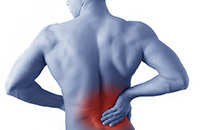
Pain in the lumbarArea may indicate the presence of stones.
Small calculi, for the time being, up to the time, may not disturb patients at all. They are recognized accidentally when a general ultrasound is performed during preventive examinations. But, if the stone in the kidney blocks the outflow of urine, appears in the lumbar region of the .With incomplete overlapping, the pain can be dull and aching.
However, stones can suddenly move and move. Ideally, the calculus passes through the ureters into the bladder and further through the urethra with urine outward. But it happens that the stone can completely clog the upper urinary tract of the affected kidney.
Signs of the exit of stones
If the stone began to move, the so-called renal colic develops. This is a formidable complication, which is manifested by severe paroxysmal pain in the lumbar region. It is cramped and so unbearable that patients sometimes rush, scream and find no place for themselves. Pain can move from the waist and give into the groin.
Symptoms of kidney stones in men are also the urge to urinate and defecate. Thus the patient feels strong dryness in a mouth, a nausea. There can be vomiting, lifting of arterial pressure. Often patients see blood in the urine and note its turbidity.
A rise in temperature up to 38 ° C and above indicates the connection of infection and the risk of acute pyelonephritis.
Diagnosis
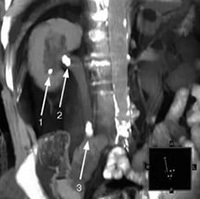
For visualization of stones in the kidney, ultrasound, contrast and excretory urography are used.
If the patient has already developed renal colic, the diagnosis can be assumed based on complaints and preliminary examination. In addition to the characteristic picture of renal colic, the exit of stones from the kidneys in the laboratory analysis of urine will reveal hematuria( blood in the urine), a large number of leukocytes and pyuria( the presence of purulent cells).In the general blood test, leukocytosis and a high rate of erythrocyte sedimentation will be noted.
If there are any doubts in the diagnosis, ultrasound diagnosis and contrast urography are used to verify the presence of concrements. Part of the stones may not be visible with these methods of research, then they turn to the help of excretory urography. You can use the services of magnetic resonance tomography or computed tomography of the kidneys. Kidney stones in men require a very serious approach to treatment. In no case, if found stone, you can not self-medicate or let the disease on its own. Such patients must necessarily be observed in urologists, periodically give a general analysis of urine and conduct monitoring ultrasound examinations.
Drug therapy
For small stones, depending on their composition, it is possible to use medicines to dissolve and prevent the formation of new concrements.
- If there are uric acid and urates in the structure of stones, then Alopurinol is effective.
- With oxalate stones, Prolite is used.
- If phosphates are combined with oxalates, you can use Cyston, which has both anti-inflammatory and diuretic effects.
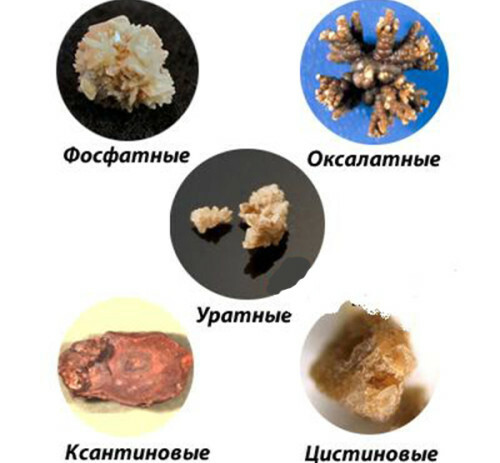
Types of kidney stones, depending on their composition.
In addition, if the stones are small( up to 5-6 millimeters), they can exit by themselves. For this, it is necessary to drink more liquid, take diuretic herbs:
- decoction of cowberry;
- Bearberry;
- horsetail field;
- juniper.
Surgical removal of
If a man has large kidney stones or recurrent renal colic, kidney stones must be surgically removed. Practical urologists have different approaches.
- Ultrasound crushing. The most gentle is the non-invasive method with the application of ultrasonic crushing. It is conducted under the supervision of ultrasound. Point by point, the special apparatus of the calculus is subjected to a powerful ultrasound action and decomposes into small pieces, which then leave with urine independently. The patient does not need anesthesia, the duration of the procedure is not more than half an hour and almost the next day a man can be discharged home under the supervision of a urologist at a polyclinic. This method is not applicable for very large stones( weighing more than 3-5 grams).
- Open surgical procedure. Sometimes it is not possible to accurately identify the location of the stone. There are variants of concrements, which are poorly visible on ultrasound and radiography. In this case, they must be removed with the help of open surgical intervention. In this case, the kidney is dissected by the scalpel of the surgeon, the stone is extracted and the postoperative sutures are applied.
- Endoscopic intervention. There is also a method of removing stones with an endoscope, when the device through the bladder and ureter is injected into the kidney, and the calculus is crushed by the laser to a size that allows them to freely exit with a current of urine. If the calculus is at the top of the kidney, the endoscope is inserted through a small surgical incision on the lateral surface of the body.
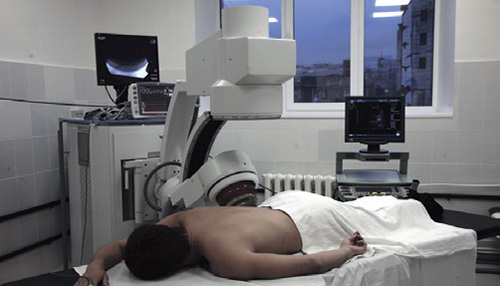
Crushing stones in the kidneys by ultrasound.
Diet
The approach to nutrition, as with drug therapy, largely depends on the type of concrements. General recommendations:
- drink more liquid( up to 3 liters per day);
- to limit salt intake( 2-3 grams per day);
- reduce meat consumption.
Read on: Month on a salt-free diet - personal experience
Also it is necessary to adjust your diet, depending on the composition of the stone:
- With oxalate stones, the products containing oxalic acid are removed. You can not eat fatty meats, broths, smoked products. Exclude beer, chocolate and tomato juice.
- If urates predominate in the concrements, then it will be necessary to abandon the by-products, beans, fatty meat, mushroom and meat broths. Contraindicated asparagus, celery and spinach.
- When phosphate stones are dangerous any kind of fish, smoked products, milk, potatoes, cocoa and alcohol.
Prevention of urolithiasis
Primary prevention
Primary prevention is given to patients with a high risk of calculus formation. As a rule, these are people with hereditary predisposition, metabolic disorders, various kinds of nephropathies, in the presence of inclusions and microlithiasis( sand) in the urine. In this case, it is necessary to recommend the intake of adequate volume of fluid, compliance with the diet, depending on the nature of the exchange and the threat of the formation of certain stones.
Secondary prophylaxis of
Secondary prophylaxis is given to patients who are at risk of recurring stones after treatment. In this case, the drug is added to the drug, depending on the type of stone( Alopurinol, Prolite, Cyston, Blamaren, etc.).The courses for taking tablets are conducted at least twice a year. A good effect has a spa treatment with mineral waters. Against this background, the acid and electrolyte composition of urine is normalized and stable remission is formed.
Read more: Kidney health: prevention and improvement of their work
Recommended viewing:

